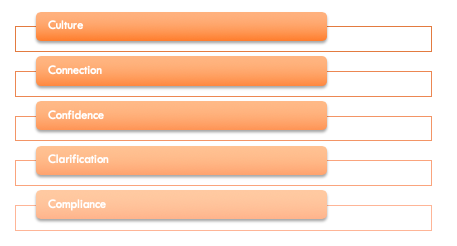Make your onboarding process more thorough, repeatable, and consistent — download the Employee Onboarding Checklist by Dr. Talya Bauer today.

Introduction
The first few weeks and months of a new employee's tenure are critical to their success in the company.
A smooth and successful onboarding process can help new hires feel welcome, valued, and prepared to do their best work.
What makes a strong employee onboarding process?
One that maximizes the ‘new employee experience’ for success.
The 5 C’s of employee onboarding is a scientific framework and foundation of a strong employee onboarding process.
What are the 5 C’s of Employee Onboarding?
Here they are in one list:
- Compliance
- Clarification
- Confidence
- Connection
- Culture
It took years of research to develop the concept of the 5 C’s, but it is surprisingly simple and powerful when put into practice.
In this post, I’ll show you a quick overview of each of the 5 C’s, and how you can use them to create a strong employee onboarding process for your company.
You can even use the 5 C's to build an employee onboarding process checklist. The first version was the 4 C's of onboarding. The latest, and revised version, is the 6 C's of onboarding framework as well.
Why You Should Audit Your Onboarding Experience
Smart HR professionals know when the recruiting and hiring process is finished, it's time to hustle.
Onboarding new hires is an entire process on its own.
Effective onboarding programs have their own best practices.
And an effective onboarding process really does have an impact on the organization's culture.
When the onboarding goes well, individuals and organizations thrive.
When onboarding goes poorly, the negative outcomes can be equally powerful with high levels of dissatisfaction, low engagement, poor performance, and high turnover.
The statistics are sobering.
Half of all hourly workers leaving their new jobs within the first 120 days.
And half of all senior outside hires fail within 18 months in a new position.
If you are asking the question, “How do you improve employee engagement,” then the 5 C’s is the best place to start.
The Scientific Framework For Onboarding New Employees
I began studying new hire onboarding and the onboarding experience over 25 years ago.
In fact, my dissertation included a study of new college graduates entering a variety of jobs.
I’ve also had a chance to study and partner with companies of all sizes in many different industries on employee onboarding solutions.
My prediction was that what happened during the recruitment process, what the manager and onboarding did while the new employee was being onboarded, as well as what the new employee did themselves were all going to be related to important outcomes such as new employee performance, job satisfaction, and retention.
Luckily, after spending only a year of my life following new hires into their new jobs and studying their onboarding successes and failures, many of these predictions turned out to be true.
In fact, over the past decades, I have been amazed at how consistent and powerful the onboarding process is in terms of these important outcomes.
All it takes is understanding which tools, or levers, are available to the organization to help new hires thrive.
As I conducted research and reviewed what worked and what didn’t, I realized that the key levers could be identified and broken down into core components.
Click here to get Dr. Talya Bauer’s onboarding checklist
In 2010, I wrote a professional practices whitepaper for the Society of Human Resource Management (SHRM) where I laid out a number of onboarding levers, including the 4 C's of onboarding.
These best practices are based on years and years of research, consulting, and observation of onboarding.
You can check that out right here: Onboarding New Employees: Maximizing Success.
These have since evolved into the 5 “C’s” of Onboarding: Compliance, Clarification, Confidence, Connection, and Culture.
While each of the original 5 C’s is an important component of onboarding, the higher up the scale from compliance to connection and culture that your organization is able to go, the more effective your onboarding program becomes.

In 2022 these have since evolved into the 6 C's of onboarding, which you can read about here.
Why 5 C’s in Employee Onboarding?
Organizations that focus on the 5 “C’s” demonstrate more successful onboarding and business outcomes than those that do not.
It actually started as 4 C's of onboarding, your can read more about them here: 4 C’s of employee onboarding?”
And you would be correct if you guessed that they were an earlier iteration of the 5 C’s minus “culture”, that was added later.
COMPLIANCE with Legal Rules and Obligations
Compliance refers to things that must be done when new employees start things like getting paperwork completed, the badging process, and provisioning tasks like equipping new employees with computers and phones as well as a workspace.
Organizations, even those who claim they do not have a formal onboarding program, have to get compliance right to stay in business.
Many employees spend their first day on the job filling out forms.
This is a missed opportunity for a majority of organizations.
Organizations spend millions of hours and billions of dollars working through the recruitment funnel of attracting candidates, identifying qualified candidates, assessing candidates, and then finally hiring them and hoping they join the organization.
But, they spend much less time thinking about ways to help make the employee experience better.
With today's technology and HR software, it's also an opportunity to streamline HR processes.
There's zero reason not to automate onboarding processes like new hire paperwork, employee records, and sharing the employee handbook.
This leaves you more time to create a memorable onboarding experience in the spots humans shine.
CLARIFICATION Roles and Expectations for New Employees
Clarification refers to how well new employees understand their roles and performance expectations.
Of course, organizations hire new employees to do specific jobs so clarifying what they need to be doing, how to do it, and how the organization functions in terms of rules and policies is important.
Plus, we know that structure and clarity are important for individual and team success.
The problem is that spending time learning the basics certainly isn’t the most exciting way to spend your time when you’re new.
Hiring managers aren't always available to answer questions.
Especially when those questions are frequent like in new hire onboarding.
So, build in ways to help new employees understand what is expected of them but the goal in doing this should be squarely focused on helping them feel equipped and confident in their choice to join your organization and their own ability to do a good job.
You may want to even invest in an onboarding tool to keep track.
With the COVID-19 pandemic and a mass movement to WFH and hybrid work models, using onboarding software may actually INCREASE employee satisfaction in this clarification step.
Build Up New Employee CONFIDENCE
Confidence refers to how much a new employee feels they can do the job well and tackle new challenges.
It is a state of mind.
While an organization cannot directly help new employees feel better about themselves, they can design an onboarding experience that help build up employees rather than tearing them down.
When employees feel more confident, they are more likely to feel good about those around them as well as the choice to join your organization.
Research conducted by Dan Cable and his colleagues found that onboarding, when done right to focus on the value of the new employee and encouraging them to share themselves at work, can immediately increase performance and retention.
This is yet another case for trying onboarding software.
Invest in an HR platform that can help you nudge and send communications at the right time.
This helps build confidence when new hires need it most.
Help New Employees Build Meaningful CONNECTIONS

Connection refers to how accepted, recognized, and valued new employees feel.
When new employees feel connected to their colleagues, they feel safe
Research has shown that a feeling of safety and connection leads to positive individual and organizational outcomes such as a willingness to ask questions and try new things.
And, they engage more fully with their coworkers, within their role, and the organization.
Moreover, they appreciate it.
Connection is a factor that leads employees to feel that they made the right choice to join the organization.
Gallup has consistently found that having a close friend at work is related to a 50% boost in job satisfaction and that those employees with a best friend at work were seven times more likely to fully engage with their work.
This starts with onboarding. If new employees feel alone and isolated on their first day, it can be challenging to recover as researchers found at Microsoft.
Relationships matter
Especially between new hires and their hiring managers.
In a study by Harvard Business School found that when new employees had a strong relationship with their hiring manager in the first two months, they were 58% more likely to be engaged at work.
I can't stress this enough.
Build in activities that build bridges between new hires, their co workers, hiring managers, and team members at large.
Of all the HR tasks, you can almost never overdo these activities in your onboarding checklist.
Make sure that you dedicate time during your onboarding process for new employees to meet their coworkers virtually or in person.
It really does help create a sense of community and improve your team and company culture.
A Strong CULTURE Attracts and Retains Your Best Employees
Culture refers to how well new hires understand the mission, vision, and values of their new organization.
These are shared in many forms, including:
- Company history
- Rituals
- Company policies
- Performance management
- Stories
- Meetings with direct managers, co workers, and team members from other departments
The list goes on.
Yet, onboarding is one of the key ways that organizational culture is formed, maintained, and changed.
When I was working at Google, we focused on onboarding as a key KPI in People Operations because the number of new employees was anticipated to double within 18 months.
That turned out to be true and the work done to identify what the Google culture was and how it would be impacted by such a huge influx of new employees was top of mind.
One important thing we had to keep in mind was that the stories of how the company was founded, its norms, missions, and its goals were evolving all the time.
Onboarding programs are a great way to teach about what matters within your organization.
It is also a great way to learn about how your organization could evolve for the better over time because new employees are the organization’s future.
If you have onboarding software, this is your chance to share documents related to company culture.
That way they're always accessible (hint: clarification).
This is also your chance to build time to meet co workers and direct managers into the new hire experience.
Learn about the 6th C of employee onboarding
What is a Good Onboarding Process?

If you answered, “One that maximizes the ‘new employee experience’ for success’ then you were paying attention.
As I explained in the beginning of this post, maximizing new employee success is the hallmark of a strong onboarding process and thus why it is important.
But you probably want to know...
Things To Consider If You're Thinking About Onboarding Software, Tools, And Tactics
I'm not here to prescribe the best set of tools. That varies from organization to organization.
Plus, like many things success boils down to committing to using those tools.
But I do have some things for you to think about.
Make sure your onboarding software can help you automate HR processes and repetitive tasks. Activities include:
- Schedule orientation meetings
- Send welcome packets or kits
- Share company policies
- Assigning a buddy or mentor
- Company culture training
- Training programs
- New hire orientation docs
- Communication — sending regular communications to new hires prior to their start date helps reduce anxiety and builds excitement for the first day.
- Collaboration — creating a system where new hires can connect with people early and often.
- Send your new hires information about your company's history, values and mission
- Teach them about your company's products or services
- Train them on job-specific skills
- Take them on a tour of the office
- Test their knowledge regularly
At the end of the day, the first step in helping create a unique and powerful employee experience is to spend the valuable first day on the job working them up the onboarding funnel to generate the biggest onboarding ROI on their first hours.
You can’t do that if all they experience is a stack of papers or online forms and waiting in long lines to get their badges.
This is a huge wasted opportunity to move down the onboarding funnel toward the high-value activities with big ROIs.
Conclusion
Onboarding is key to success for any organization, yet it's often overlooked or done poorly.
Use the 5 C's of employee onboarding to create a successful program: culture, communication, compliance, connection, and content.
When you focus on these key areas, you'll be able to create an onboarding process that sets your new employees up for success.
Click here to get Dr. Talya Bauer’s onboarding checklist